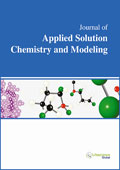jascm
Abstract : Synthesis and Computational Investigations of Ruthenium(II) Complexes Containing Hydrazine Schiff Base Ligands
|
|
Abstract: Three new heteroleptic ruthenium(II) complexes containing hydrazine schiff base as ligands were synthesized and characterized by using elemental analysis, FT-IR, 1H, 13C NMR, and mass spectroscopic techniques. FT-IR study showed that the substituted phenylhydrazine ligands behave as a monoanionic bidentate O and N donors (L) coordinate to ruthenium via the deprotonated phenolic oxygen and the azomethine nitrogen. They possess excellent thermal stabilities, evident from the thermal decomposition temperatures. Absorption, emission and electrochemical measurements were carried out and the structures of the synthesized complex were optimized using density functional theory (DFT). The molecular geometry, the highest occupied molecular orbital (HOMO), the lowest unoccupied molecular orbital (LUMO) energies, Mulliken atomic charges and molecular electrostatic potential (MEP) of the molecules are determined using B3LYP method and standard 6-311++G (d, p) basis set. Keywords: |
Abstract : Analysis of Thermodynamic Properties forRare Earth Complexes in Ionic Liquids by Raman Spectroscopy and DFT Calculation
|
|
Abstract: The coordination states of the divalent and trivalent rare earth complexes in ionic liquid, triethyl-pentyl-phosphonium bis(trifluoromethyl-sulfonyl) amide [P2225][TFSA] were investigated by Raman spectroscopy and DFT calculation. The concentration dependences of the deconvoluted Raman spectra were investigated for 0.23–0.45 mol kg-1 RE(III), RE=Nd and Dy, and the mixed sample of RE(II)/RE(III)=1/3 at the molar ratio in [P2225][TFSA]. According to the conventional analysis, the solvation number; n of rare earth complexes in [P2225][TFSA] were determined to be n=4.06 for Nd(II), 5.01 for Nd(III), 4.12 for Dy(II) and 5.00 for Dy(III). Thermodynamic properties such as ΔisoG, ΔisoH and ΔisoS for the isomerism of [TFSA]- from trans- to cis-isomer in bulk and the first solvation sphere of the centered [RE3+] cation in [P2225][TFSA] were evaluated from the temperature dependence in the range of 298-398K. ΔisoG(bulk), ΔisoH(bulk) and TΔisoS(bulk) at 298 K were -1.06, 6.86, and 7.92 kJ mol-1, respectively. The trans-[TFSA]-was dominant in the enthalpy due to the positive value of ΔisoH(bulk) and TΔisoS(bulk) was slightly larger than ΔisoH(bulk), so that cis-[TFSA]-was revealed to be an entropy-controlled in [P2225][TFSA]. On the other hand, in the first solvation sphere of [RE3+] cation, ΔisoH (Nd)(-47.39 kJ mol-1) increased to the negative value remarkably and implied that the cis-[TFSA]- isomers were stabilized for enthalpy. ΔisoH(Nd) contributed to the remarkable decrease in the ΔisoG(Nd) and this result clearly indicated that the cis-[TFSA]- bound to Nd3+ cation was preferred and the coordination state of [Dy(III)(cis-TFSA)5]2- was stable in [P2225][TFSA] The optimized geometries and the bonding energies of [RE(II)(cis-TFSA)4]2- and [RE(III)(cis-TFSA)5]2- clusters were also investigated from DFT calculation with ADF package. The bonding energy; ΔEb was calculated from ΔEb= Etot(cluster) –Etot(RE2,3+) –nEtot([TFSA]-). ΔEb([Nd(II)(cis-TFSA)4]2-), ΔEb([Nd(III)(cis-TFSA)5]2-), ΔEb([Dy(II)(cis-TFSA)4]2-) and ΔEb([Dy(III)(cis-TFSA)5]2-) were -2241.6, -4362.3, -2135.4 and -4284.2 kJmol-1, respectively. This result was revealed that [RE(III)(cis-TFSA)5]2-cluster formed stronger coordination bonds than [Dy(II)(cis-TFSA)4]2- cluster. The average atomic charges and the bond distances of these clusters were consistent with the thermodynamic properties. Keywords: Coordination state, DFT calculation, Rare earth, Raman spectroscopy, Thermodynamic property.Download Full Article |
Abstract : Ultrasonic Investigation of α-Amino Acids with Aqueous Solution of Urea at Different Temperatures: A Physicochemical Study
|
|
Abstract: The present paper reflects the ultrasonic investigations for exploring the inter-ionic interactions of various concentrations of a-amino acids such as L-Arginine, L-lysine monohydrochloride, and L -histidine in aqueous solutions of urea over a wide ranges of temperatures (298.15 to 323.15) K under atmospheric pressure. It also represent the detail showing that molecular interactions between the a-amino acids and urea has much dissociation of proteins in the solvent mixture. The study of ultrasonic speed and sound velocity were successfully preformed on the liquid ternary mixtures. With the help of the above mentioned parameter, the values of isentropic compressibility, change in isentropic compressibility , relative change in isentropic compressibility , relative association , specific acoustic impedance , and apparent molal isentropic compressibility were calculated. These parameters have been examined in term of the molecular associations such as ion-ion, ion-solvent, solute-solvent, solute-solute etc., and briefly described in terms of the structure-making ability corresponding to a-amino acids in the urea. Efforts have been taken to explore the dependency of the outcomes related to temperature and concentration. Keywords: Amino acids, urea, Zwitterions-ions interactions, ion-solvent, solute-solvent.Download Full Article |
Abstract : Removal of Dyes of Textile Rejects by Activated Carbon
|
|
Abstract: The composition of wastewater from the textile industry varies enormously from one moment to another depending on the nature of the dyes used, the type of tissue, methods used and the concentration of added chemicals. In most cases the dye effluents are characterized by strong color, high temperatures, high and random values of pH, amounts of suspended solids and COD-concentrations close to the limit values set by the draft Moroccan standards. The study of turbidity indicates a variation between 120 and 190 NTU for the three samples. As for their conductivity varies between 5,2 and 20 mS.cm-1. Moreover their pH varies in the field of basic pH. Measuring the temperature of these three samples showed values varying between 25 and 30 ° C. The levels of suspended solids range between 146,8 and 514,7 mg L-1. The results show that the measured absorbance at 436 nm decreased to 2,020 A and it stabilizes at this value. To the absorbance of the color measured at 525 nm decreases to 3,072 A and it stabilizes. The absorbance measured at the wavelength 620 nm decreases and reaches a minimum value of 1, 918 A after ten hours. Keywords: Activated carbon, turbidity, absorbance, adsorption, waste water. Download Full Article |






















